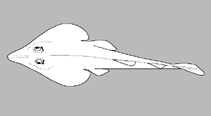Rhinobatos ranongensis Last, Séret & Naylor, 2019
Ranong guitarfish
Common names from other countries
分類 / Names 俗名 | 同種異名 | Catalog of Fishes(屬, 種) | ITIS | CoL | WoRMS | Cloffa
Elasmobranchii 板鰓亞綱 (鯊魚與魟魚) (sharks and rays) > Rhinopristiformes (Shovelnose rays) 鰩目 (Shovelnose rays) > Rhinobatidae (Guitarfishes) 琵琶鱝科 (Guitarfishes)
Etymology: Rhinobatos: Greek, rhinos = nose + Greek, batis, -idos = a ray (Raja sp.) (Ref. 45335); ranongensis: Named for the Ranong fish landing in western Thailand, where the first specimen was collected 25 years ago, and subsequently most of the types.
Etymology: Rhinobatos: Greek, rhinos = nose + Greek, batis, -idos = a ray (Raja sp.) (Ref. 45335); ranongensis: Named for the Ranong fish landing in western Thailand, where the first specimen was collected 25 years ago, and subsequently most of the types.
Environment: milieu / climate zone / depth range / distribution range 生態學
海洋 居於水底的; 深度上下限 30 - 69 m (Ref. 123963).
分布 國家 | FAO區域 | 生態系 | 發現紀錄 | Point map | 簡介 | Faunafri
Eastern Indian Ocean: Andaman Sea, Myanmar and western Thailand.
大小 / 重量 / 年齡
簡短描述 檢索表 | 型態特徵 | 形態測量圖
This medium-sized species is distinguished by the following set of characters in adult male: disc is wedge-shaped and relatively narrow, its width 31-33% TL, length 1.3-1.4 times width; snout moderately elongate, its length 3.0–3.2 times interspiracular distance, 4.1-4.4 times interorbital width; orbit and spiracular openings are small, orbit diameter ~1.5 times spiracle length; nostrils weakly oblique, length 1.3-1.6 times internarial distance; mouth narrow, 5.4-6.0% TL; preoral length 6.3-6.9 times internarial distance; posterior nasal flaps are broad; spiracular folds 2, the outermost fold slightly taller than inner fold; ridges of rostral cartilage are almost parallel, converging anteriorly but not constricted medially; anterior cartilage is broadly sickle shaped, truncate posteriorly; gill slits and their interspaces are narrow, distance between fifth gill slits 3.0-3.2 times in ventral head length; prebranchial sensory pore system distinct, extending to just behind margin of first gill slit; postscapular sensory canal indistinct, deeply embedded, not forming shallow groove; thorn patches present on supraorbit and scapular region, and row along dorsal midline rudimentary, inconspicuous; denticles on dorsal fins are densest anteriorly, present but more sparse posteriorly; dorsal fins are small, height of first 5.4-6.2% TL; pelvic-fin inner margin subequal to its base length; interdorsal distance 2.9-3.3 times first dorsal-fin base; dorsal caudal margin 2.0-2.4 times the preventral margin; upper jaw with 68-82 tooth rows; snout angle 59-64°; pectoral radials 64-68; post-synarcual centra 172-176; nasal lamellae 47-48. Colouration: dorsal fins brownish anteriorly, dusky posteriorly; dorsal disc of adults largely uniformly brownish, no spots or obvious blotches; no large, black, teardrop marking on undersurface of snout (Ref. 123963)
Caught individuals: males at 49.4 and 50.3 cm TL were immature and the largest female (51.1 cm TL) was most probably at late adolescent or early mature stage of development (Ref. 123963).
Life cycle and mating behavior 成熟度 | 繁殖 | 產卵場 | 卵 | 孕卵數 | 仔魚
主要參考資料
Upload your references | 參考文獻 | 合作者 : McEachran, John | 合作者
Last, P.R., B. Séret and G.J.P. Naylor, 2019. Description of Rhinobatos ranongensis sp. nov.(Rhinopristiformes: Rhinobatidae) from the Andaman Sea and Bay of Bengal with a review of its northern Indian Ocean congeners. Zootaxa 4576(2):257-287. (Ref. 123963)
對人類具威脅
人類使用
FAO(Publication : search) | FishSource |
更多資訊
Trophic ecology
食物相
食性組成
食物消耗量
Food rations
捕食者
食物相
食性組成
食物消耗量
Food rations
捕食者
Ecology
生態學
Home ranges
生態學
Home ranges
Population dynamics
成長參數
Max. ages / sizes
Length-weight rel.
Length-length rel.
長度-頻率
Mass conversion
入添量
豐度
成長參數
Max. ages / sizes
Length-weight rel.
Length-length rel.
長度-頻率
Mass conversion
入添量
豐度
Life cycle
繁殖
成熟度
孕卵數
產卵場
Spawning aggregations
卵
卵發育
仔魚
稚魚動力學
繁殖
成熟度
孕卵數
產卵場
Spawning aggregations
卵
卵發育
仔魚
稚魚動力學
Anatomy
鰓區
Brain
Otolith
鰓區
Brain
Otolith
Physiology
Body composition
Nutrients
耗氧量
游泳類型
游泳速度
Visual pigments
Fish sound
Diseases & Parasites
Toxicity (LC50s)
Body composition
Nutrients
耗氧量
游泳類型
游泳速度
Visual pigments
Fish sound
Diseases & Parasites
Toxicity (LC50s)
Genetics
遺傳學
Heterozygosity
遺傳率
遺傳學
Heterozygosity
遺傳率
工具
E-book | 野外調查 | 長度- 頻率 Wizard | 生活- 歷史的工具 | 分布圖 | Classification Tree
| Catch-MSY |
特別的報告
下載 XML
網路資源
Aquatic Commons | BHL | Cloffa | Websites from users | 檢查 FishWatcher | CISTI | Catalog of Fishes(屬, 種) | DiscoverLife | ECOTOX | Faunafri | Fishtrace | GenBank(基因組, 核甘) | GloBI | GOBASE | | Google Books | Google Scholar | Google | IGFA World Record | MitoFish | Otolith Atlas of Taiwan Fishes | PubMed | Reef Life Survey | Scirus | SeaLifeBase | 樹狀分類階層 | Wikipedia(去, 搜尋) | World Records Freshwater Fishing | Zoobank | 動物學的記錄
Estimates based on models
Phylogenetic diversity index (Ref. 82804): PD50 = No PD50 data [Uniqueness, from 0.5 = low to 2.0 = high].
Bayesian length-weight: a=0.00295 (0.00151 - 0.00578), b=3.13 (2.96 - 3.30), in cm Total Length, based on LWR estimates for this (Sub)family-body shape (Ref. 93245).
營養階層 (Ref. 69278): 3.7 ±0.4 se; based on size and trophs of closest relatives
回復力 (Ref. 120179): 低的, 最小族群倍增時間4.5 - 14 年 (Preliminary low fecundity).
Fishing Vulnerability (Ref. 59153): Moderate to high vulnerability (46 of 100).




